International Hospitality Management: Strategic Growth Analysis of IHG
VerifiedAdded on 2023/06/16
|13
|3749
|347
Report
AI Summary
This report provides a comprehensive analysis of Intercontinental Hotel Group's (IHG) growth strategies within the international hospitality management sector. It begins by outlining the background of the hospitality industry and IHG, followed by a SWOT analysis to identify the company's strengths, weaknesses, opportunities, and threats. The report evaluates emerging markets for IHG, such as China, India, and the Middle East, and conducts a PESTLE analysis to assess the external factors impacting the business. It then discusses various hotel strategies, including Porter's generic strategies and the Ansoff model, to be adopted and implemented using a strategic model, with justification for their selection. The report concludes with a discussion of the practical application of these strategies for organizational growth and development, highlighting the importance of adapting to market dynamics and leveraging technological advancements to enhance customer experience and maintain a competitive edge. Desklib offers a range of resources for students studying similar topics, including past papers and solved assignments.
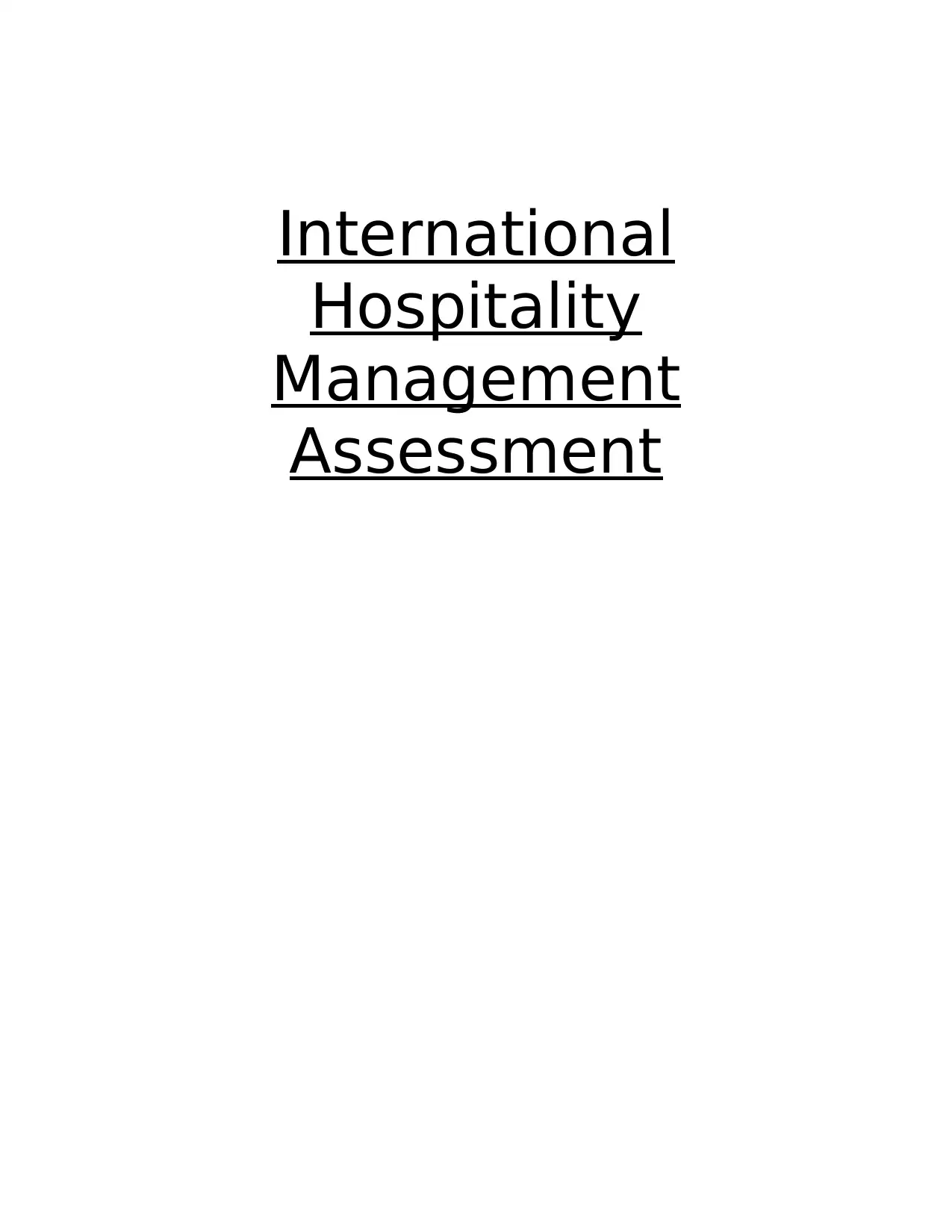
International
Hospitality
Management
Assessment
Hospitality
Management
Assessment
Paraphrase This Document
Need a fresh take? Get an instant paraphrase of this document with our AI Paraphraser
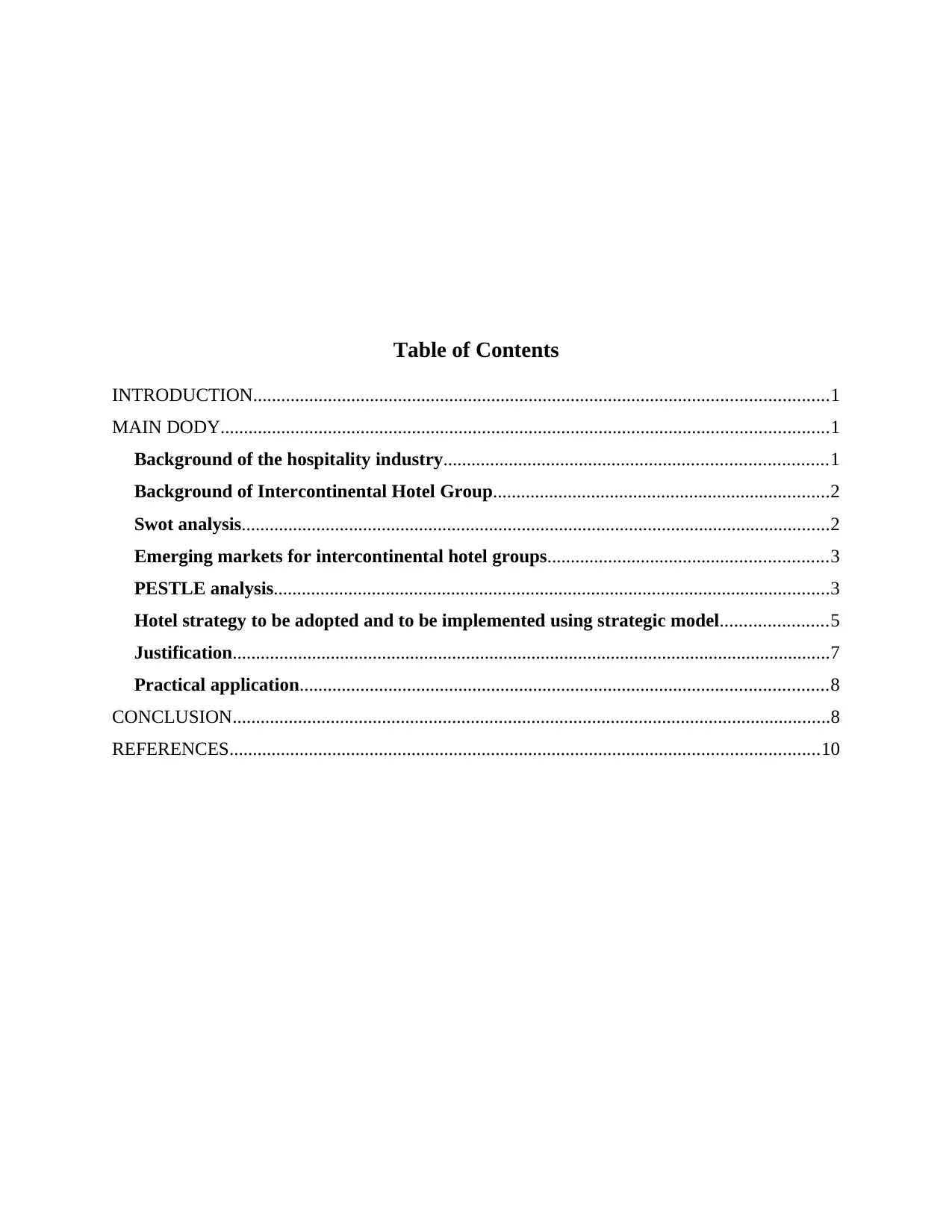
Table of Contents
INTRODUCTION...........................................................................................................................1
MAIN DODY..................................................................................................................................1
Background of the hospitality industry..................................................................................1
Background of Intercontinental Hotel Group........................................................................2
Swot analysis..............................................................................................................................2
Emerging markets for intercontinental hotel groups............................................................3
PESTLE analysis.......................................................................................................................3
Hotel strategy to be adopted and to be implemented using strategic model.......................5
Justification................................................................................................................................7
Practical application.................................................................................................................8
CONCLUSION................................................................................................................................8
REFERENCES..............................................................................................................................10
INTRODUCTION...........................................................................................................................1
MAIN DODY..................................................................................................................................1
Background of the hospitality industry..................................................................................1
Background of Intercontinental Hotel Group........................................................................2
Swot analysis..............................................................................................................................2
Emerging markets for intercontinental hotel groups............................................................3
PESTLE analysis.......................................................................................................................3
Hotel strategy to be adopted and to be implemented using strategic model.......................5
Justification................................................................................................................................7
Practical application.................................................................................................................8
CONCLUSION................................................................................................................................8
REFERENCES..............................................................................................................................10
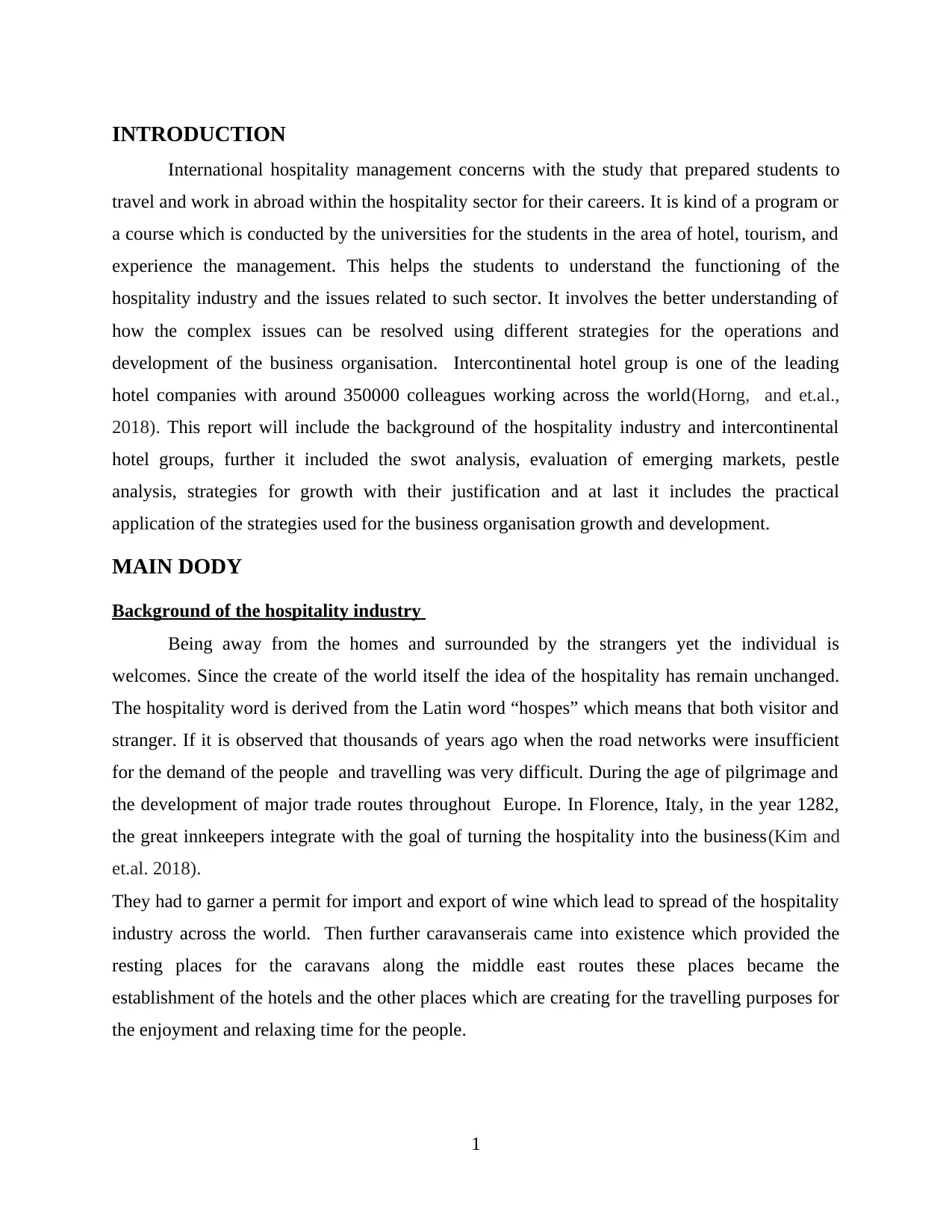
INTRODUCTION
International hospitality management concerns with the study that prepared students to
travel and work in abroad within the hospitality sector for their careers. It is kind of a program or
a course which is conducted by the universities for the students in the area of hotel, tourism, and
experience the management. This helps the students to understand the functioning of the
hospitality industry and the issues related to such sector. It involves the better understanding of
how the complex issues can be resolved using different strategies for the operations and
development of the business organisation. Intercontinental hotel group is one of the leading
hotel companies with around 350000 colleagues working across the world(Horng, and et.al.,
2018). This report will include the background of the hospitality industry and intercontinental
hotel groups, further it included the swot analysis, evaluation of emerging markets, pestle
analysis, strategies for growth with their justification and at last it includes the practical
application of the strategies used for the business organisation growth and development.
MAIN DODY
Background of the hospitality industry
Being away from the homes and surrounded by the strangers yet the individual is
welcomes. Since the create of the world itself the idea of the hospitality has remain unchanged.
The hospitality word is derived from the Latin word “hospes” which means that both visitor and
stranger. If it is observed that thousands of years ago when the road networks were insufficient
for the demand of the people and travelling was very difficult. During the age of pilgrimage and
the development of major trade routes throughout Europe. In Florence, Italy, in the year 1282,
the great innkeepers integrate with the goal of turning the hospitality into the business(Kim and
et.al. 2018).
They had to garner a permit for import and export of wine which lead to spread of the hospitality
industry across the world. Then further caravanserais came into existence which provided the
resting places for the caravans along the middle east routes these places became the
establishment of the hotels and the other places which are creating for the travelling purposes for
the enjoyment and relaxing time for the people.
1
International hospitality management concerns with the study that prepared students to
travel and work in abroad within the hospitality sector for their careers. It is kind of a program or
a course which is conducted by the universities for the students in the area of hotel, tourism, and
experience the management. This helps the students to understand the functioning of the
hospitality industry and the issues related to such sector. It involves the better understanding of
how the complex issues can be resolved using different strategies for the operations and
development of the business organisation. Intercontinental hotel group is one of the leading
hotel companies with around 350000 colleagues working across the world(Horng, and et.al.,
2018). This report will include the background of the hospitality industry and intercontinental
hotel groups, further it included the swot analysis, evaluation of emerging markets, pestle
analysis, strategies for growth with their justification and at last it includes the practical
application of the strategies used for the business organisation growth and development.
MAIN DODY
Background of the hospitality industry
Being away from the homes and surrounded by the strangers yet the individual is
welcomes. Since the create of the world itself the idea of the hospitality has remain unchanged.
The hospitality word is derived from the Latin word “hospes” which means that both visitor and
stranger. If it is observed that thousands of years ago when the road networks were insufficient
for the demand of the people and travelling was very difficult. During the age of pilgrimage and
the development of major trade routes throughout Europe. In Florence, Italy, in the year 1282,
the great innkeepers integrate with the goal of turning the hospitality into the business(Kim and
et.al. 2018).
They had to garner a permit for import and export of wine which lead to spread of the hospitality
industry across the world. Then further caravanserais came into existence which provided the
resting places for the caravans along the middle east routes these places became the
establishment of the hotels and the other places which are creating for the travelling purposes for
the enjoyment and relaxing time for the people.
1
⊘ This is a preview!⊘
Do you want full access?
Subscribe today to unlock all pages.

Trusted by 1+ million students worldwide
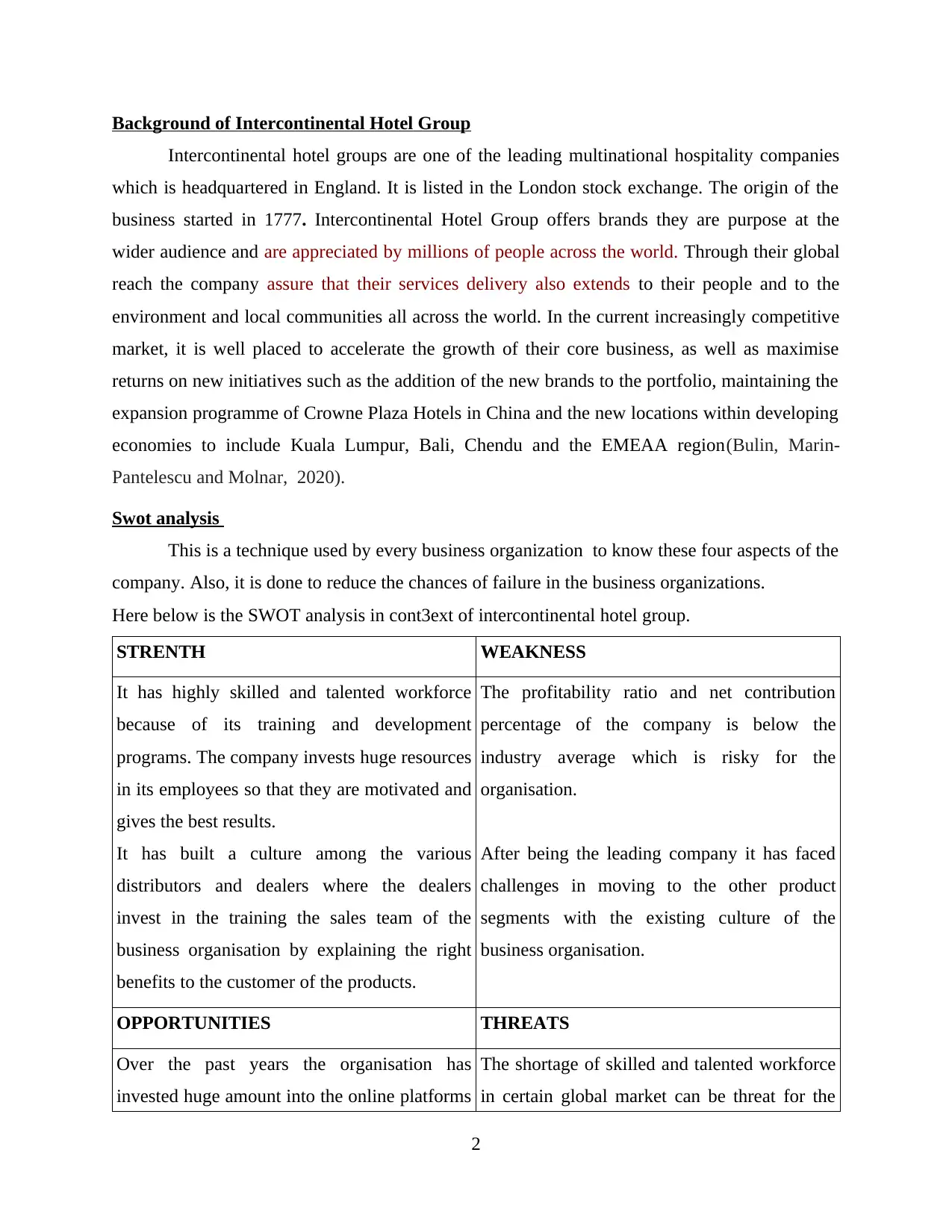
Background of Intercontinental Hotel Group
Intercontinental hotel groups are one of the leading multinational hospitality companies
which is headquartered in England. It is listed in the London stock exchange. The origin of the
business started in 1777. Intercontinental Hotel Group offers brands they are purpose at the
wider audience and are appreciated by millions of people across the world. Through their global
reach the company assure that their services delivery also extends to their people and to the
environment and local communities all across the world. In the current increasingly competitive
market, it is well placed to accelerate the growth of their core business, as well as maximise
returns on new initiatives such as the addition of the new brands to the portfolio, maintaining the
expansion programme of Crowne Plaza Hotels in China and the new locations within developing
economies to include Kuala Lumpur, Bali, Chendu and the EMEAA region(Bulin, Marin-
Pantelescu and Molnar, 2020).
Swot analysis
This is a technique used by every business organization to know these four aspects of the
company. Also, it is done to reduce the chances of failure in the business organizations.
Here below is the SWOT analysis in cont3ext of intercontinental hotel group.
STRENTH WEAKNESS
It has highly skilled and talented workforce
because of its training and development
programs. The company invests huge resources
in its employees so that they are motivated and
gives the best results.
It has built a culture among the various
distributors and dealers where the dealers
invest in the training the sales team of the
business organisation by explaining the right
benefits to the customer of the products.
The profitability ratio and net contribution
percentage of the company is below the
industry average which is risky for the
organisation.
After being the leading company it has faced
challenges in moving to the other product
segments with the existing culture of the
business organisation.
OPPORTUNITIES THREATS
Over the past years the organisation has
invested huge amount into the online platforms
The shortage of skilled and talented workforce
in certain global market can be threat for the
2
Intercontinental hotel groups are one of the leading multinational hospitality companies
which is headquartered in England. It is listed in the London stock exchange. The origin of the
business started in 1777. Intercontinental Hotel Group offers brands they are purpose at the
wider audience and are appreciated by millions of people across the world. Through their global
reach the company assure that their services delivery also extends to their people and to the
environment and local communities all across the world. In the current increasingly competitive
market, it is well placed to accelerate the growth of their core business, as well as maximise
returns on new initiatives such as the addition of the new brands to the portfolio, maintaining the
expansion programme of Crowne Plaza Hotels in China and the new locations within developing
economies to include Kuala Lumpur, Bali, Chendu and the EMEAA region(Bulin, Marin-
Pantelescu and Molnar, 2020).
Swot analysis
This is a technique used by every business organization to know these four aspects of the
company. Also, it is done to reduce the chances of failure in the business organizations.
Here below is the SWOT analysis in cont3ext of intercontinental hotel group.
STRENTH WEAKNESS
It has highly skilled and talented workforce
because of its training and development
programs. The company invests huge resources
in its employees so that they are motivated and
gives the best results.
It has built a culture among the various
distributors and dealers where the dealers
invest in the training the sales team of the
business organisation by explaining the right
benefits to the customer of the products.
The profitability ratio and net contribution
percentage of the company is below the
industry average which is risky for the
organisation.
After being the leading company it has faced
challenges in moving to the other product
segments with the existing culture of the
business organisation.
OPPORTUNITIES THREATS
Over the past years the organisation has
invested huge amount into the online platforms
The shortage of skilled and talented workforce
in certain global market can be threat for the
2
Paraphrase This Document
Need a fresh take? Get an instant paraphrase of this document with our AI Paraphraser
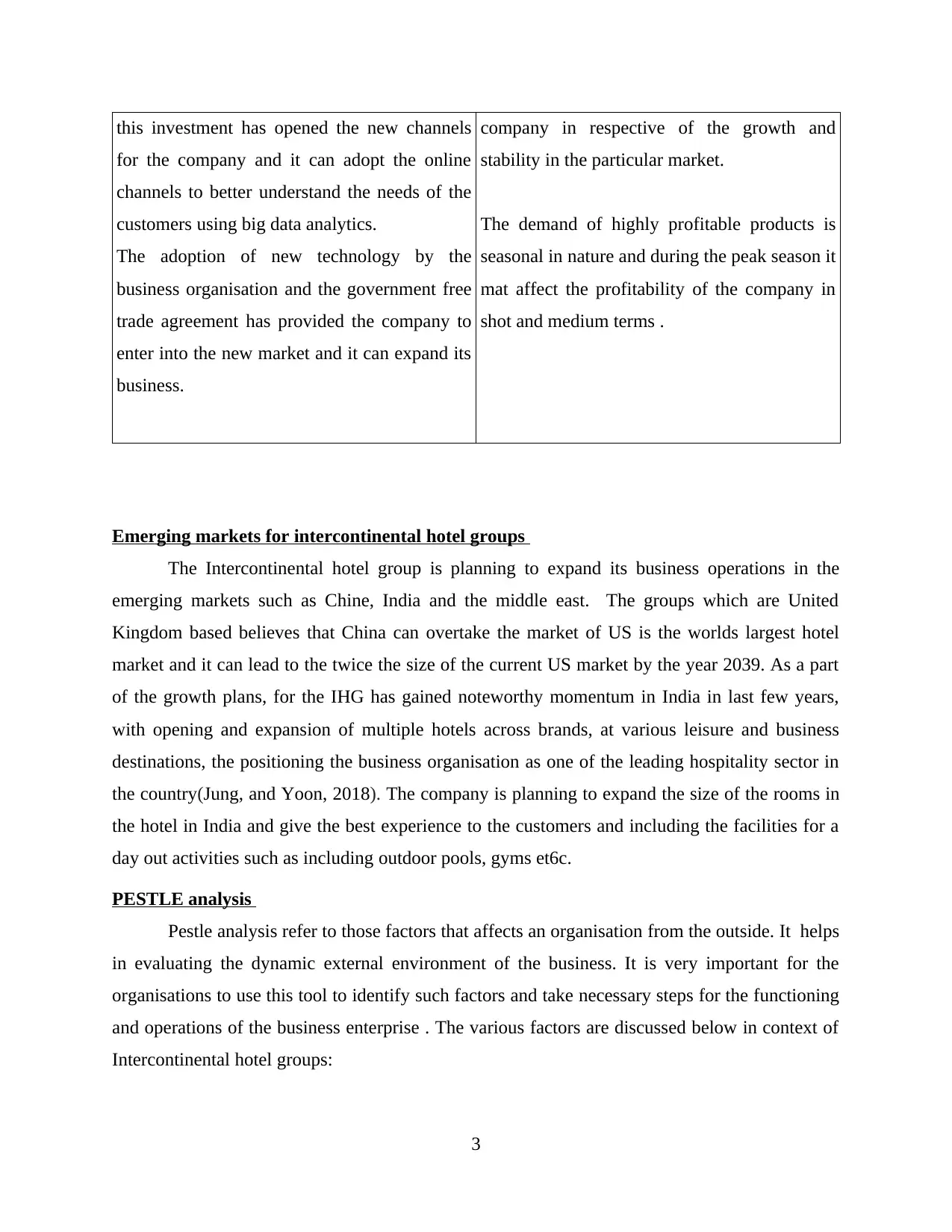
this investment has opened the new channels
for the company and it can adopt the online
channels to better understand the needs of the
customers using big data analytics.
The adoption of new technology by the
business organisation and the government free
trade agreement has provided the company to
enter into the new market and it can expand its
business.
company in respective of the growth and
stability in the particular market.
The demand of highly profitable products is
seasonal in nature and during the peak season it
mat affect the profitability of the company in
shot and medium terms .
Emerging markets for intercontinental hotel groups
The Intercontinental hotel group is planning to expand its business operations in the
emerging markets such as Chine, India and the middle east. The groups which are United
Kingdom based believes that China can overtake the market of US is the worlds largest hotel
market and it can lead to the twice the size of the current US market by the year 2039. As a part
of the growth plans, for the IHG has gained noteworthy momentum in India in last few years,
with opening and expansion of multiple hotels across brands, at various leisure and business
destinations, the positioning the business organisation as one of the leading hospitality sector in
the country(Jung, and Yoon, 2018). The company is planning to expand the size of the rooms in
the hotel in India and give the best experience to the customers and including the facilities for a
day out activities such as including outdoor pools, gyms et6c.
PESTLE analysis
Pestle analysis refer to those factors that affects an organisation from the outside. It helps
in evaluating the dynamic external environment of the business. It is very important for the
organisations to use this tool to identify such factors and take necessary steps for the functioning
and operations of the business enterprise . The various factors are discussed below in context of
Intercontinental hotel groups:
3
for the company and it can adopt the online
channels to better understand the needs of the
customers using big data analytics.
The adoption of new technology by the
business organisation and the government free
trade agreement has provided the company to
enter into the new market and it can expand its
business.
company in respective of the growth and
stability in the particular market.
The demand of highly profitable products is
seasonal in nature and during the peak season it
mat affect the profitability of the company in
shot and medium terms .
Emerging markets for intercontinental hotel groups
The Intercontinental hotel group is planning to expand its business operations in the
emerging markets such as Chine, India and the middle east. The groups which are United
Kingdom based believes that China can overtake the market of US is the worlds largest hotel
market and it can lead to the twice the size of the current US market by the year 2039. As a part
of the growth plans, for the IHG has gained noteworthy momentum in India in last few years,
with opening and expansion of multiple hotels across brands, at various leisure and business
destinations, the positioning the business organisation as one of the leading hospitality sector in
the country(Jung, and Yoon, 2018). The company is planning to expand the size of the rooms in
the hotel in India and give the best experience to the customers and including the facilities for a
day out activities such as including outdoor pools, gyms et6c.
PESTLE analysis
Pestle analysis refer to those factors that affects an organisation from the outside. It helps
in evaluating the dynamic external environment of the business. It is very important for the
organisations to use this tool to identify such factors and take necessary steps for the functioning
and operations of the business enterprise . The various factors are discussed below in context of
Intercontinental hotel groups:
3
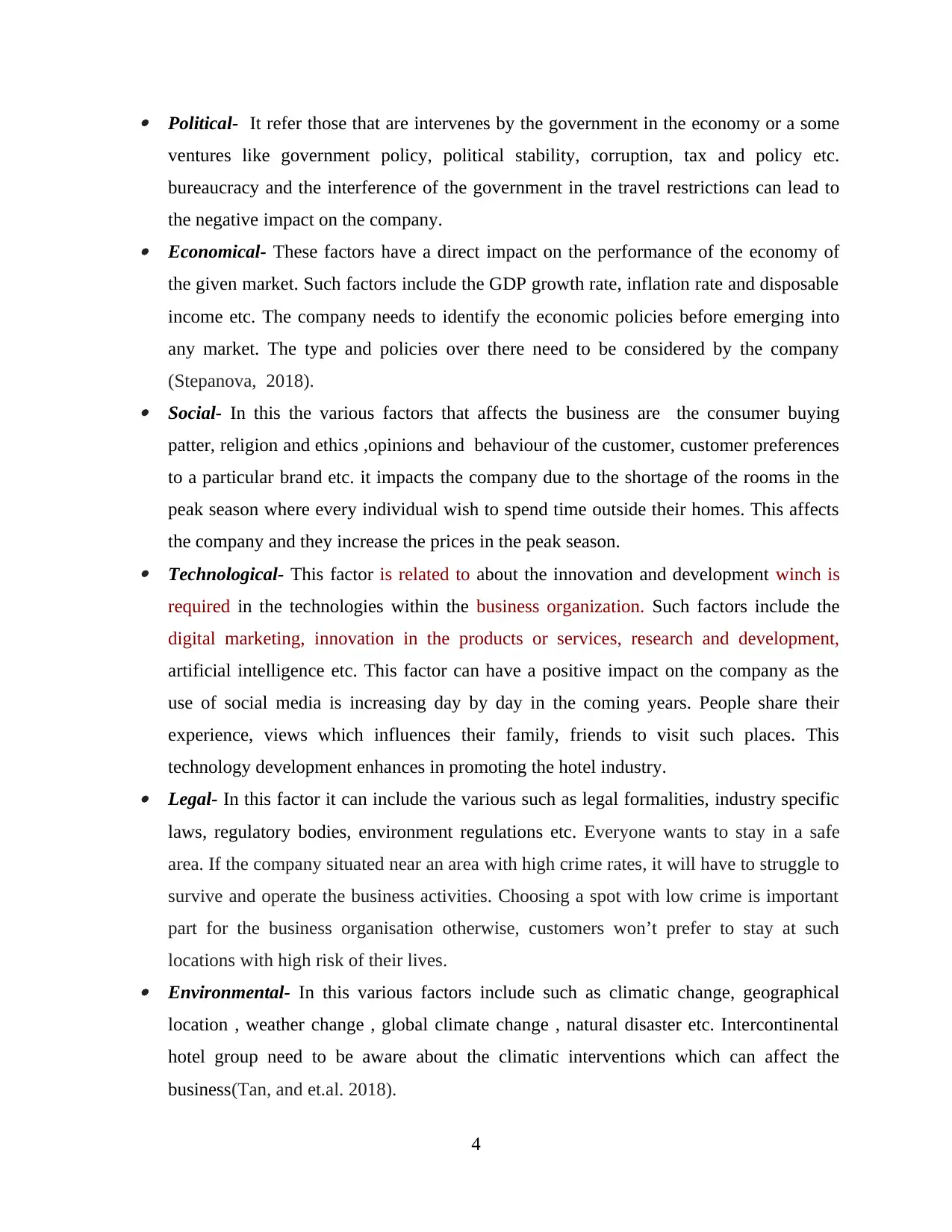
Political- It refer those that are intervenes by the government in the economy or a some
ventures like government policy, political stability, corruption, tax and policy etc.
bureaucracy and the interference of the government in the travel restrictions can lead to
the negative impact on the company. Economical- These factors have a direct impact on the performance of the economy of
the given market. Such factors include the GDP growth rate, inflation rate and disposable
income etc. The company needs to identify the economic policies before emerging into
any market. The type and policies over there need to be considered by the company
(Stepanova, 2018). Social- In this the various factors that affects the business are the consumer buying
patter, religion and ethics ,opinions and behaviour of the customer, customer preferences
to a particular brand etc. it impacts the company due to the shortage of the rooms in the
peak season where every individual wish to spend time outside their homes. This affects
the company and they increase the prices in the peak season. Technological- This factor is related to about the innovation and development winch is
required in the technologies within the business organization. Such factors include the
digital marketing, innovation in the products or services, research and development,
artificial intelligence etc. This factor can have a positive impact on the company as the
use of social media is increasing day by day in the coming years. People share their
experience, views which influences their family, friends to visit such places. This
technology development enhances in promoting the hotel industry. Legal- In this factor it can include the various such as legal formalities, industry specific
laws, regulatory bodies, environment regulations etc. Everyone wants to stay in a safe
area. If the company situated near an area with high crime rates, it will have to struggle to
survive and operate the business activities. Choosing a spot with low crime is important
part for the business organisation otherwise, customers won’t prefer to stay at such
locations with high risk of their lives. Environmental- In this various factors include such as climatic change, geographical
location , weather change , global climate change , natural disaster etc. Intercontinental
hotel group need to be aware about the climatic interventions which can affect the
business(Tan, and et.al. 2018).
4
ventures like government policy, political stability, corruption, tax and policy etc.
bureaucracy and the interference of the government in the travel restrictions can lead to
the negative impact on the company. Economical- These factors have a direct impact on the performance of the economy of
the given market. Such factors include the GDP growth rate, inflation rate and disposable
income etc. The company needs to identify the economic policies before emerging into
any market. The type and policies over there need to be considered by the company
(Stepanova, 2018). Social- In this the various factors that affects the business are the consumer buying
patter, religion and ethics ,opinions and behaviour of the customer, customer preferences
to a particular brand etc. it impacts the company due to the shortage of the rooms in the
peak season where every individual wish to spend time outside their homes. This affects
the company and they increase the prices in the peak season. Technological- This factor is related to about the innovation and development winch is
required in the technologies within the business organization. Such factors include the
digital marketing, innovation in the products or services, research and development,
artificial intelligence etc. This factor can have a positive impact on the company as the
use of social media is increasing day by day in the coming years. People share their
experience, views which influences their family, friends to visit such places. This
technology development enhances in promoting the hotel industry. Legal- In this factor it can include the various such as legal formalities, industry specific
laws, regulatory bodies, environment regulations etc. Everyone wants to stay in a safe
area. If the company situated near an area with high crime rates, it will have to struggle to
survive and operate the business activities. Choosing a spot with low crime is important
part for the business organisation otherwise, customers won’t prefer to stay at such
locations with high risk of their lives. Environmental- In this various factors include such as climatic change, geographical
location , weather change , global climate change , natural disaster etc. Intercontinental
hotel group need to be aware about the climatic interventions which can affect the
business(Tan, and et.al. 2018).
4
⊘ This is a preview!⊘
Do you want full access?
Subscribe today to unlock all pages.

Trusted by 1+ million students worldwide
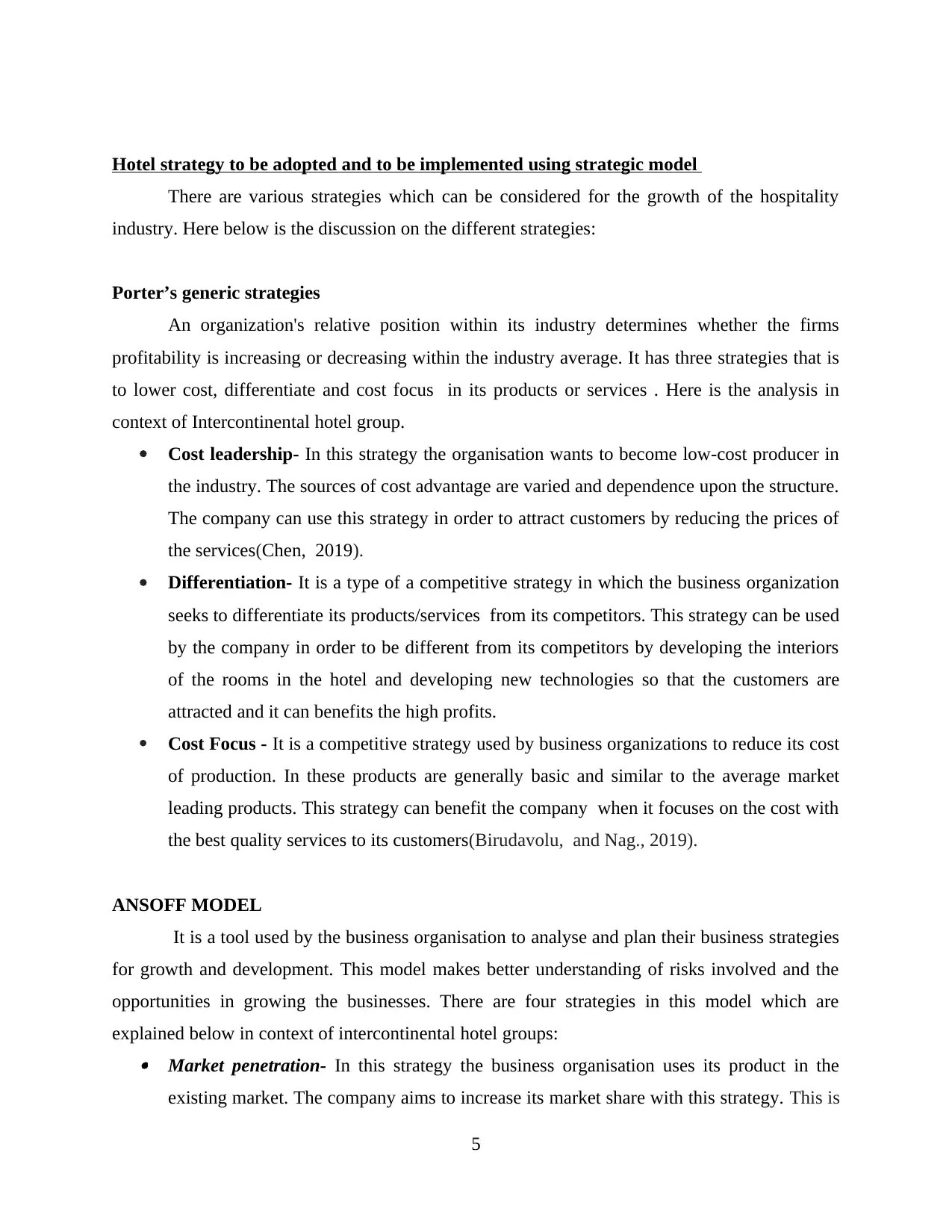
Hotel strategy to be adopted and to be implemented using strategic model
There are various strategies which can be considered for the growth of the hospitality
industry. Here below is the discussion on the different strategies:
Porter’s generic strategies
An organization's relative position within its industry determines whether the firms
profitability is increasing or decreasing within the industry average. It has three strategies that is
to lower cost, differentiate and cost focus in its products or services . Here is the analysis in
context of Intercontinental hotel group.
Cost leadership- In this strategy the organisation wants to become low-cost producer in
the industry. The sources of cost advantage are varied and dependence upon the structure.
The company can use this strategy in order to attract customers by reducing the prices of
the services(Chen, 2019).
Differentiation- It is a type of a competitive strategy in which the business organization
seeks to differentiate its products/services from its competitors. This strategy can be used
by the company in order to be different from its competitors by developing the interiors
of the rooms in the hotel and developing new technologies so that the customers are
attracted and it can benefits the high profits.
Cost Focus - It is a competitive strategy used by business organizations to reduce its cost
of production. In these products are generally basic and similar to the average market
leading products. This strategy can benefit the company when it focuses on the cost with
the best quality services to its customers(Birudavolu, and Nag., 2019).
ANSOFF MODEL
It is a tool used by the business organisation to analyse and plan their business strategies
for growth and development. This model makes better understanding of risks involved and the
opportunities in growing the businesses. There are four strategies in this model which are
explained below in context of intercontinental hotel groups: Market penetration- In this strategy the business organisation uses its product in the
existing market. The company aims to increase its market share with this strategy. This is
5
There are various strategies which can be considered for the growth of the hospitality
industry. Here below is the discussion on the different strategies:
Porter’s generic strategies
An organization's relative position within its industry determines whether the firms
profitability is increasing or decreasing within the industry average. It has three strategies that is
to lower cost, differentiate and cost focus in its products or services . Here is the analysis in
context of Intercontinental hotel group.
Cost leadership- In this strategy the organisation wants to become low-cost producer in
the industry. The sources of cost advantage are varied and dependence upon the structure.
The company can use this strategy in order to attract customers by reducing the prices of
the services(Chen, 2019).
Differentiation- It is a type of a competitive strategy in which the business organization
seeks to differentiate its products/services from its competitors. This strategy can be used
by the company in order to be different from its competitors by developing the interiors
of the rooms in the hotel and developing new technologies so that the customers are
attracted and it can benefits the high profits.
Cost Focus - It is a competitive strategy used by business organizations to reduce its cost
of production. In these products are generally basic and similar to the average market
leading products. This strategy can benefit the company when it focuses on the cost with
the best quality services to its customers(Birudavolu, and Nag., 2019).
ANSOFF MODEL
It is a tool used by the business organisation to analyse and plan their business strategies
for growth and development. This model makes better understanding of risks involved and the
opportunities in growing the businesses. There are four strategies in this model which are
explained below in context of intercontinental hotel groups: Market penetration- In this strategy the business organisation uses its product in the
existing market. The company aims to increase its market share with this strategy. This is
5
Paraphrase This Document
Need a fresh take? Get an instant paraphrase of this document with our AI Paraphraser
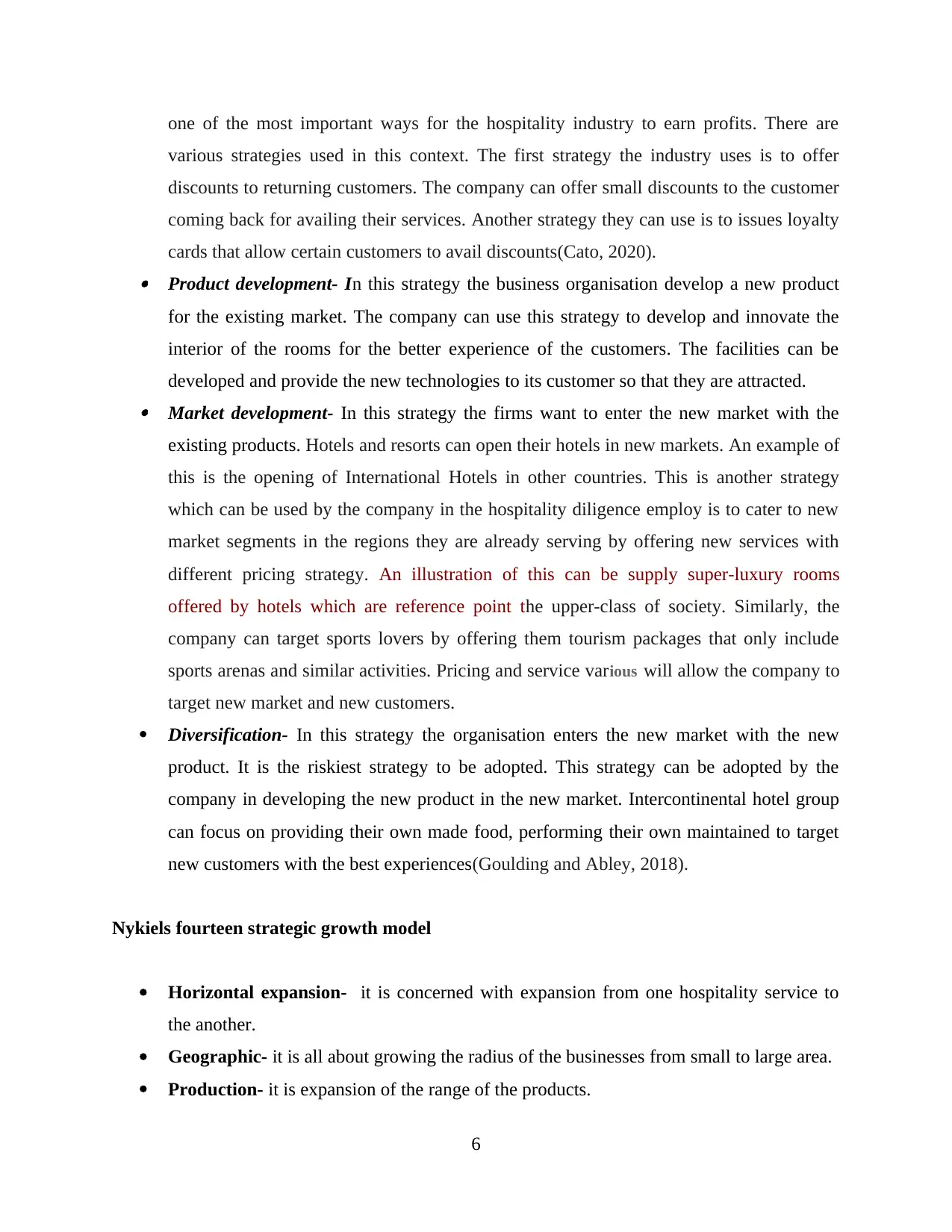
one of the most important ways for the hospitality industry to earn profits. There are
various strategies used in this context. The first strategy the industry uses is to offer
discounts to returning customers. The company can offer small discounts to the customer
coming back for availing their services. Another strategy they can use is to issues loyalty
cards that allow certain customers to avail discounts(Cato, 2020). Product development- In this strategy the business organisation develop a new product
for the existing market. The company can use this strategy to develop and innovate the
interior of the rooms for the better experience of the customers. The facilities can be
developed and provide the new technologies to its customer so that they are attracted. Market development- In this strategy the firms want to enter the new market with the
existing products. Hotels and resorts can open their hotels in new markets. An example of
this is the opening of International Hotels in other countries. This is another strategy
which can be used by the company in the hospitality diligence employ is to cater to new
market segments in the regions they are already serving by offering new services with
different pricing strategy. An illustration of this can be supply super-luxury rooms
offered by hotels which are reference point the upper-class of society. Similarly, the
company can target sports lovers by offering them tourism packages that only include
sports arenas and similar activities. Pricing and service various will allow the company to
target new market and new customers.
Diversification- In this strategy the organisation enters the new market with the new
product. It is the riskiest strategy to be adopted. This strategy can be adopted by the
company in developing the new product in the new market. Intercontinental hotel group
can focus on providing their own made food, performing their own maintained to target
new customers with the best experiences(Goulding and Abley, 2018).
Nykiels fourteen strategic growth model
Horizontal expansion- it is concerned with expansion from one hospitality service to
the another.
Geographic- it is all about growing the radius of the businesses from small to large area.
Production- it is expansion of the range of the products.
6
various strategies used in this context. The first strategy the industry uses is to offer
discounts to returning customers. The company can offer small discounts to the customer
coming back for availing their services. Another strategy they can use is to issues loyalty
cards that allow certain customers to avail discounts(Cato, 2020). Product development- In this strategy the business organisation develop a new product
for the existing market. The company can use this strategy to develop and innovate the
interior of the rooms for the better experience of the customers. The facilities can be
developed and provide the new technologies to its customer so that they are attracted. Market development- In this strategy the firms want to enter the new market with the
existing products. Hotels and resorts can open their hotels in new markets. An example of
this is the opening of International Hotels in other countries. This is another strategy
which can be used by the company in the hospitality diligence employ is to cater to new
market segments in the regions they are already serving by offering new services with
different pricing strategy. An illustration of this can be supply super-luxury rooms
offered by hotels which are reference point the upper-class of society. Similarly, the
company can target sports lovers by offering them tourism packages that only include
sports arenas and similar activities. Pricing and service various will allow the company to
target new market and new customers.
Diversification- In this strategy the organisation enters the new market with the new
product. It is the riskiest strategy to be adopted. This strategy can be adopted by the
company in developing the new product in the new market. Intercontinental hotel group
can focus on providing their own made food, performing their own maintained to target
new customers with the best experiences(Goulding and Abley, 2018).
Nykiels fourteen strategic growth model
Horizontal expansion- it is concerned with expansion from one hospitality service to
the another.
Geographic- it is all about growing the radius of the businesses from small to large area.
Production- it is expansion of the range of the products.
6
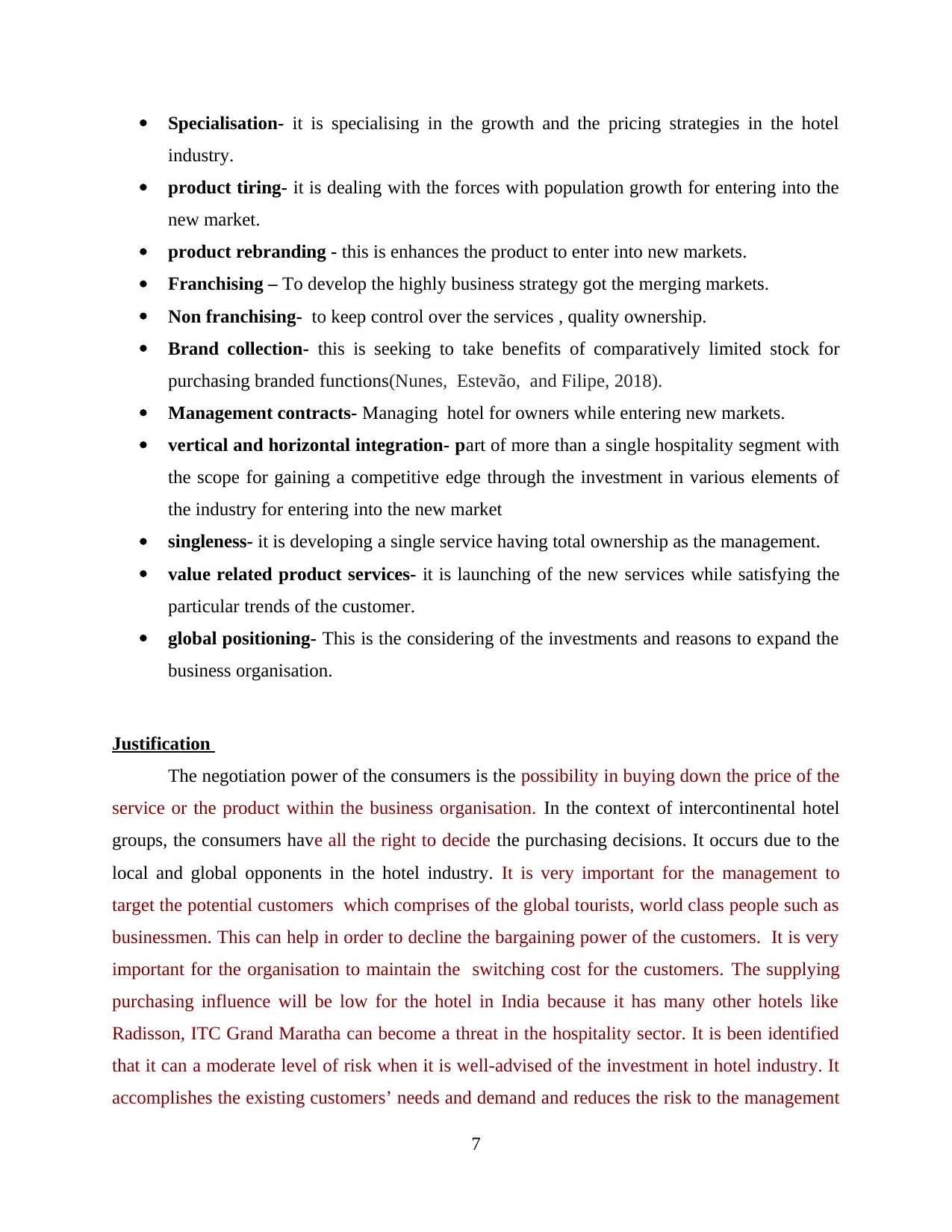
Specialisation- it is specialising in the growth and the pricing strategies in the hotel
industry.
product tiring- it is dealing with the forces with population growth for entering into the
new market.
product rebranding - this is enhances the product to enter into new markets.
Franchising – To develop the highly business strategy got the merging markets.
Non franchising- to keep control over the services , quality ownership.
Brand collection- this is seeking to take benefits of comparatively limited stock for
purchasing branded functions(Nunes, Estevão, and Filipe, 2018).
Management contracts- Managing hotel for owners while entering new markets.
vertical and horizontal integration- part of more than a single hospitality segment with
the scope for gaining a competitive edge through the investment in various elements of
the industry for entering into the new market
singleness- it is developing a single service having total ownership as the management.
value related product services- it is launching of the new services while satisfying the
particular trends of the customer.
global positioning- This is the considering of the investments and reasons to expand the
business organisation.
Justification
The negotiation power of the consumers is the possibility in buying down the price of the
service or the product within the business organisation. In the context of intercontinental hotel
groups, the consumers have all the right to decide the purchasing decisions. It occurs due to the
local and global opponents in the hotel industry. It is very important for the management to
target the potential customers which comprises of the global tourists, world class people such as
businessmen. This can help in order to decline the bargaining power of the customers. It is very
important for the organisation to maintain the switching cost for the customers. The supplying
purchasing influence will be low for the hotel in India because it has many other hotels like
Radisson, ITC Grand Maratha can become a threat in the hospitality sector. It is been identified
that it can a moderate level of risk when it is well-advised of the investment in hotel industry. It
accomplishes the existing customers’ needs and demand and reduces the risk to the management
7
industry.
product tiring- it is dealing with the forces with population growth for entering into the
new market.
product rebranding - this is enhances the product to enter into new markets.
Franchising – To develop the highly business strategy got the merging markets.
Non franchising- to keep control over the services , quality ownership.
Brand collection- this is seeking to take benefits of comparatively limited stock for
purchasing branded functions(Nunes, Estevão, and Filipe, 2018).
Management contracts- Managing hotel for owners while entering new markets.
vertical and horizontal integration- part of more than a single hospitality segment with
the scope for gaining a competitive edge through the investment in various elements of
the industry for entering into the new market
singleness- it is developing a single service having total ownership as the management.
value related product services- it is launching of the new services while satisfying the
particular trends of the customer.
global positioning- This is the considering of the investments and reasons to expand the
business organisation.
Justification
The negotiation power of the consumers is the possibility in buying down the price of the
service or the product within the business organisation. In the context of intercontinental hotel
groups, the consumers have all the right to decide the purchasing decisions. It occurs due to the
local and global opponents in the hotel industry. It is very important for the management to
target the potential customers which comprises of the global tourists, world class people such as
businessmen. This can help in order to decline the bargaining power of the customers. It is very
important for the organisation to maintain the switching cost for the customers. The supplying
purchasing influence will be low for the hotel in India because it has many other hotels like
Radisson, ITC Grand Maratha can become a threat in the hospitality sector. It is been identified
that it can a moderate level of risk when it is well-advised of the investment in hotel industry. It
accomplishes the existing customers’ needs and demand and reduces the risk to the management
7
⊘ This is a preview!⊘
Do you want full access?
Subscribe today to unlock all pages.

Trusted by 1+ million students worldwide
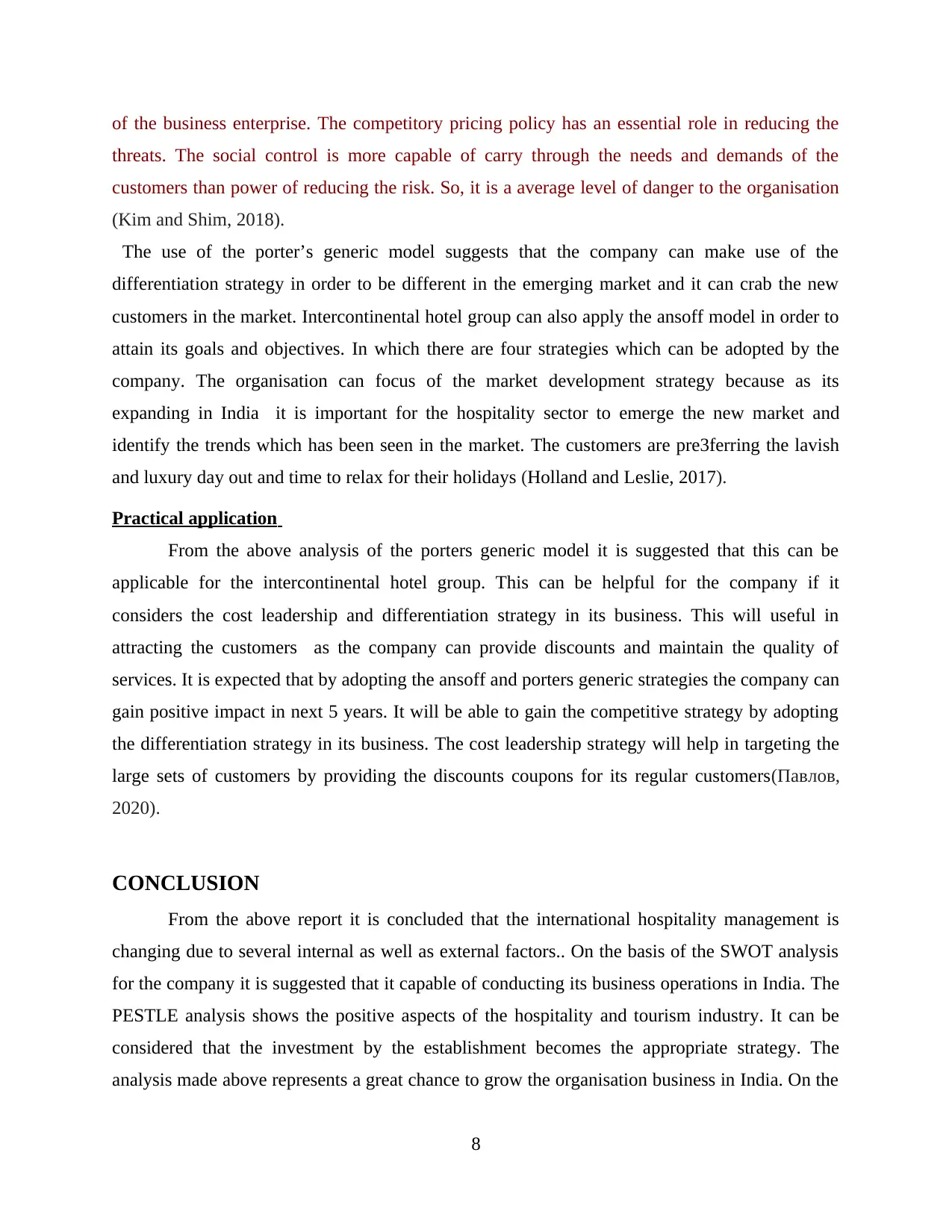
of the business enterprise. The competitory pricing policy has an essential role in reducing the
threats. The social control is more capable of carry through the needs and demands of the
customers than power of reducing the risk. So, it is a average level of danger to the organisation
(Kim and Shim, 2018).
The use of the porter’s generic model suggests that the company can make use of the
differentiation strategy in order to be different in the emerging market and it can crab the new
customers in the market. Intercontinental hotel group can also apply the ansoff model in order to
attain its goals and objectives. In which there are four strategies which can be adopted by the
company. The organisation can focus of the market development strategy because as its
expanding in India it is important for the hospitality sector to emerge the new market and
identify the trends which has been seen in the market. The customers are pre3ferring the lavish
and luxury day out and time to relax for their holidays (Holland and Leslie, 2017).
Practical application
From the above analysis of the porters generic model it is suggested that this can be
applicable for the intercontinental hotel group. This can be helpful for the company if it
considers the cost leadership and differentiation strategy in its business. This will useful in
attracting the customers as the company can provide discounts and maintain the quality of
services. It is expected that by adopting the ansoff and porters generic strategies the company can
gain positive impact in next 5 years. It will be able to gain the competitive strategy by adopting
the differentiation strategy in its business. The cost leadership strategy will help in targeting the
large sets of customers by providing the discounts coupons for its regular customers(Павлов,
2020).
CONCLUSION
From the above report it is concluded that the international hospitality management is
changing due to several internal as well as external factors.. On the basis of the SWOT analysis
for the company it is suggested that it capable of conducting its business operations in India. The
PESTLE analysis shows the positive aspects of the hospitality and tourism industry. It can be
considered that the investment by the establishment becomes the appropriate strategy. The
analysis made above represents a great chance to grow the organisation business in India. On the
8
threats. The social control is more capable of carry through the needs and demands of the
customers than power of reducing the risk. So, it is a average level of danger to the organisation
(Kim and Shim, 2018).
The use of the porter’s generic model suggests that the company can make use of the
differentiation strategy in order to be different in the emerging market and it can crab the new
customers in the market. Intercontinental hotel group can also apply the ansoff model in order to
attain its goals and objectives. In which there are four strategies which can be adopted by the
company. The organisation can focus of the market development strategy because as its
expanding in India it is important for the hospitality sector to emerge the new market and
identify the trends which has been seen in the market. The customers are pre3ferring the lavish
and luxury day out and time to relax for their holidays (Holland and Leslie, 2017).
Practical application
From the above analysis of the porters generic model it is suggested that this can be
applicable for the intercontinental hotel group. This can be helpful for the company if it
considers the cost leadership and differentiation strategy in its business. This will useful in
attracting the customers as the company can provide discounts and maintain the quality of
services. It is expected that by adopting the ansoff and porters generic strategies the company can
gain positive impact in next 5 years. It will be able to gain the competitive strategy by adopting
the differentiation strategy in its business. The cost leadership strategy will help in targeting the
large sets of customers by providing the discounts coupons for its regular customers(Павлов,
2020).
CONCLUSION
From the above report it is concluded that the international hospitality management is
changing due to several internal as well as external factors.. On the basis of the SWOT analysis
for the company it is suggested that it capable of conducting its business operations in India. The
PESTLE analysis shows the positive aspects of the hospitality and tourism industry. It can be
considered that the investment by the establishment becomes the appropriate strategy. The
analysis made above represents a great chance to grow the organisation business in India. On the
8
Paraphrase This Document
Need a fresh take? Get an instant paraphrase of this document with our AI Paraphraser
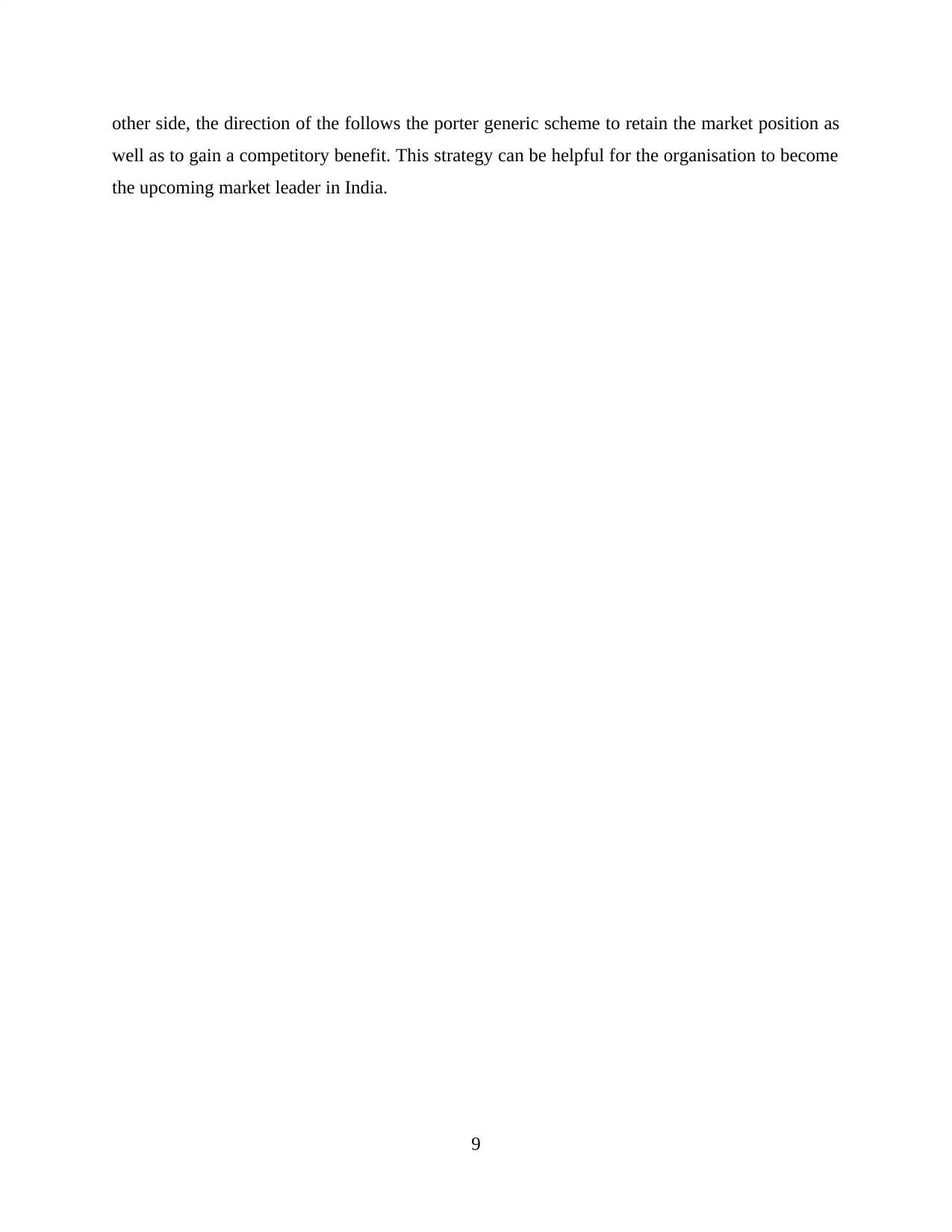
other side, the direction of the follows the porter generic scheme to retain the market position as
well as to gain a competitory benefit. This strategy can be helpful for the organisation to become
the upcoming market leader in India.
9
well as to gain a competitory benefit. This strategy can be helpful for the organisation to become
the upcoming market leader in India.
9
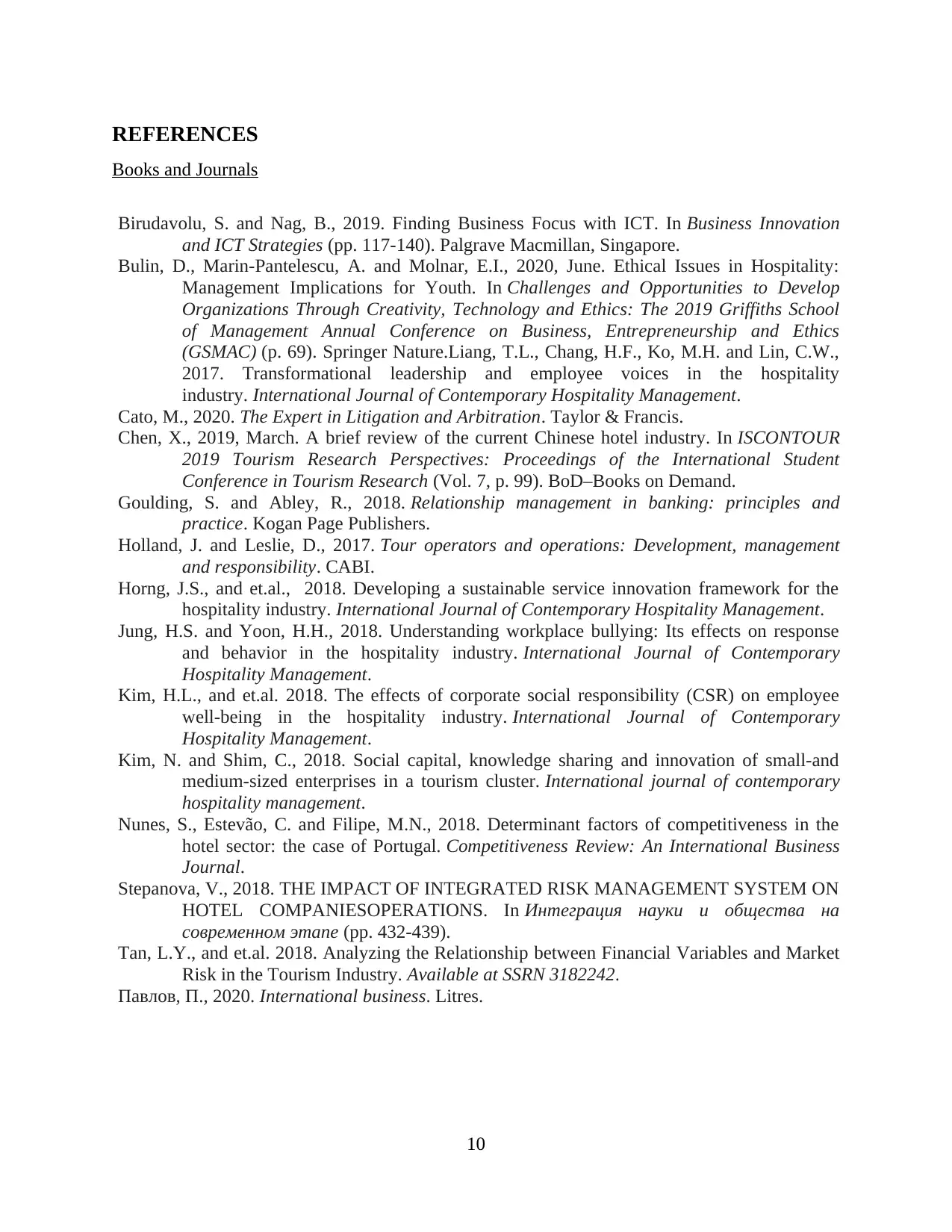
REFERENCES
Books and Journals
Birudavolu, S. and Nag, B., 2019. Finding Business Focus with ICT. In Business Innovation
and ICT Strategies (pp. 117-140). Palgrave Macmillan, Singapore.
Bulin, D., Marin-Pantelescu, A. and Molnar, E.I., 2020, June. Ethical Issues in Hospitality:
Management Implications for Youth. In Challenges and Opportunities to Develop
Organizations Through Creativity, Technology and Ethics: The 2019 Griffiths School
of Management Annual Conference on Business, Entrepreneurship and Ethics
(GSMAC) (p. 69). Springer Nature.Liang, T.L., Chang, H.F., Ko, M.H. and Lin, C.W.,
2017. Transformational leadership and employee voices in the hospitality
industry. International Journal of Contemporary Hospitality Management.
Cato, M., 2020. The Expert in Litigation and Arbitration. Taylor & Francis.
Chen, X., 2019, March. A brief review of the current Chinese hotel industry. In ISCONTOUR
2019 Tourism Research Perspectives: Proceedings of the International Student
Conference in Tourism Research (Vol. 7, p. 99). BoD–Books on Demand.
Goulding, S. and Abley, R., 2018. Relationship management in banking: principles and
practice. Kogan Page Publishers.
Holland, J. and Leslie, D., 2017. Tour operators and operations: Development, management
and responsibility. CABI.
Horng, J.S., and et.al., 2018. Developing a sustainable service innovation framework for the
hospitality industry. International Journal of Contemporary Hospitality Management.
Jung, H.S. and Yoon, H.H., 2018. Understanding workplace bullying: Its effects on response
and behavior in the hospitality industry. International Journal of Contemporary
Hospitality Management.
Kim, H.L., and et.al. 2018. The effects of corporate social responsibility (CSR) on employee
well-being in the hospitality industry. International Journal of Contemporary
Hospitality Management.
Kim, N. and Shim, C., 2018. Social capital, knowledge sharing and innovation of small-and
medium-sized enterprises in a tourism cluster. International journal of contemporary
hospitality management.
Nunes, S., Estevão, C. and Filipe, M.N., 2018. Determinant factors of competitiveness in the
hotel sector: the case of Portugal. Competitiveness Review: An International Business
Journal.
Stepanova, V., 2018. THE IMPACT OF INTEGRATED RISK MANAGEMENT SYSTEM ON
HOTEL COMPANIESOPERATIONS. In Интеграция науки и общества на
современном этапе (pp. 432-439).
Tan, L.Y., and et.al. 2018. Analyzing the Relationship between Financial Variables and Market
Risk in the Tourism Industry. Available at SSRN 3182242.
Павлов, П., 2020. International business. Litres.
10
Books and Journals
Birudavolu, S. and Nag, B., 2019. Finding Business Focus with ICT. In Business Innovation
and ICT Strategies (pp. 117-140). Palgrave Macmillan, Singapore.
Bulin, D., Marin-Pantelescu, A. and Molnar, E.I., 2020, June. Ethical Issues in Hospitality:
Management Implications for Youth. In Challenges and Opportunities to Develop
Organizations Through Creativity, Technology and Ethics: The 2019 Griffiths School
of Management Annual Conference on Business, Entrepreneurship and Ethics
(GSMAC) (p. 69). Springer Nature.Liang, T.L., Chang, H.F., Ko, M.H. and Lin, C.W.,
2017. Transformational leadership and employee voices in the hospitality
industry. International Journal of Contemporary Hospitality Management.
Cato, M., 2020. The Expert in Litigation and Arbitration. Taylor & Francis.
Chen, X., 2019, March. A brief review of the current Chinese hotel industry. In ISCONTOUR
2019 Tourism Research Perspectives: Proceedings of the International Student
Conference in Tourism Research (Vol. 7, p. 99). BoD–Books on Demand.
Goulding, S. and Abley, R., 2018. Relationship management in banking: principles and
practice. Kogan Page Publishers.
Holland, J. and Leslie, D., 2017. Tour operators and operations: Development, management
and responsibility. CABI.
Horng, J.S., and et.al., 2018. Developing a sustainable service innovation framework for the
hospitality industry. International Journal of Contemporary Hospitality Management.
Jung, H.S. and Yoon, H.H., 2018. Understanding workplace bullying: Its effects on response
and behavior in the hospitality industry. International Journal of Contemporary
Hospitality Management.
Kim, H.L., and et.al. 2018. The effects of corporate social responsibility (CSR) on employee
well-being in the hospitality industry. International Journal of Contemporary
Hospitality Management.
Kim, N. and Shim, C., 2018. Social capital, knowledge sharing and innovation of small-and
medium-sized enterprises in a tourism cluster. International journal of contemporary
hospitality management.
Nunes, S., Estevão, C. and Filipe, M.N., 2018. Determinant factors of competitiveness in the
hotel sector: the case of Portugal. Competitiveness Review: An International Business
Journal.
Stepanova, V., 2018. THE IMPACT OF INTEGRATED RISK MANAGEMENT SYSTEM ON
HOTEL COMPANIESOPERATIONS. In Интеграция науки и общества на
современном этапе (pp. 432-439).
Tan, L.Y., and et.al. 2018. Analyzing the Relationship between Financial Variables and Market
Risk in the Tourism Industry. Available at SSRN 3182242.
Павлов, П., 2020. International business. Litres.
10
⊘ This is a preview!⊘
Do you want full access?
Subscribe today to unlock all pages.

Trusted by 1+ million students worldwide
1 out of 13
Related Documents
Your All-in-One AI-Powered Toolkit for Academic Success.
+13062052269
info@desklib.com
Available 24*7 on WhatsApp / Email
![[object Object]](/_next/static/media/star-bottom.7253800d.svg)
Unlock your academic potential
Copyright © 2020–2025 A2Z Services. All Rights Reserved. Developed and managed by ZUCOL.



